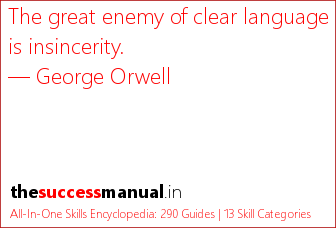How To Write In A Plain Language
Plain language | Plain writing
1. What is plain language?
When you write in plain language, you are using your words with economy, and write at a level your target audience can easily understand. Most of the time, plain language means talking directly with the reader ('you', 'I').
2. You will start to learn the important of and use plain language, once you get into your target reader's shoes (empathy). Plain language follows the same big rule of good communication: Know your audience.
3. Plain language writing does not have these problems: Long sentences, passive voice, weak verbs, jargon/multiple definitions/abstractions, unnecessary details, or superfluous words/phrases. Most of the time, plain language writing also shorter, concise writing.
4. What are Readability scores?
Readability scores tell how readable a document is, based on readability criteria of number of syllables used per word and the average number of words per sentences. There are scales such as the Flesch scale, which score documents for their readability levels. The general idea is to write at the understanding level of a eighth grade student.
Most word processors, such as Microsoft Word have in-built readability scoring tools. Look under 'tools'
5. Passive voice
Everyone you come across will tell you to avoid using passive voice. And they are right most of the time. Passive voice takes the action away from the subject, reducing the impact and responsibility of the action. It kills the tension of action. 'John Connor stabbed Edison' sounds better than 'Edison was stabbed by John Connor'. The first sentences keeps building up the action.
Formula for passive sentences:
- a form of the passive auxiliary BE (be/been/is/are/was/were),
- followed by a verb,
- and then a past form (verb + ed or an irregular past form).
Passive sentences can make an impact when used rarely, often to show the emotional impact. E.g. A paragraph describing all the bad stuff that had taken place in a woman's house, and then the last sentences goes, 'She was uttterly devastated by now.'
Tips for writing plainly
1. Always use one word replacements for phrases: E.g. Use 'about' instead of 'in regard to', or 'twice' instead of 'on two separate occasions'. Search Google for 'plain language alternatives', or 'word replacements'.
2. Try not to use 'winding' starts: E.g. 'To be perfectly honest', or 'I would like to say'. Just get on with what you have to say.
3. Using ‘you’ and ‘we’ keeps your sentences short, clear and personal.
4. Always choose appropriate words for your reader. Use words that your reader will understand.
5. Give your instructions directly, without using long-winded instructions etc that the user finds hard to follow. Use maps and diagrams that the reader can follow easily.
6. Arrange sentences in way that they send a positive message.
Instead of, 'If you don't give us your address, we won't be able to send you your payment.', write 'Please provide your address so we can send you your payment.'
7. Don't use a verb or an adjective as a noun. (these are called nominalizations.)
Avoid using words with such endings as -ion, -tion, -ing, -ment, -ent, -ance, -ence, -ancy, -ency.
For example, regarding the commencement of, finalize making a decision...etc
These words sound too formal and distant.
8. Make lists to break up long sentences.
One way is to put a colon in between. For example, 'Two ways to connect the dots:...' (in these sentences, the period comes after the last entry.)
9. Be precise: Don't use words loosely. For example, Verbal and Oral. Verbal means words, and oral means spoken words. When you say 'He instructed me verbally', when you probably meant to say that 'He instructed me orally'.
Please search Google for more 'confusing words'.
10. Use Parallel Structure
Parallel structure means using the same pattern of words/phrase/clause, to have a better rhythm of sentences. Parallel structure is especially needed when you make a bullet list.
For example, 'John Connor likes biking on lonely roads, shooting at angry machines, and searching for the next Skynet node.'
11. Write as you speak (most of the time, depending on the audience). This way you will avoid using big phrases, which we don't normally do in real life, when talking with friends. Use everyday words only.
12. You can sometimes (not often) start sentences with ‘and’, ‘but’, ‘so’, ‘because’ and ‘however’. (this writer breaks this rule often)
13. Be careful with acronyms: Remember the rules - ASBMAETP (Acronyms Should Be Memorable And Easy To Pronounce), and SATAN (Select Acronyms That Are Non-offensive).
13. Avoid repeating yourself.
14. For better readability, format your document better:
Use sans serif headings (Helvetica, Arial, etc.) and serif body text (Calibri,Times New Roman, etc.) to distinguish the headings from the text, making it easy to scan.
Use only kind of emphasis in a document (bold, italic or underline - don't capitalize headings, it is distracting).
Group related matter under headings.
Use up 3 levels hierarchy max (heading, sub-heading, sub-sub-heading).
❤ If you liked this, consider supporting us by checking out Tiny Skills - 250+ Top Work & Personal Skills Made Easy